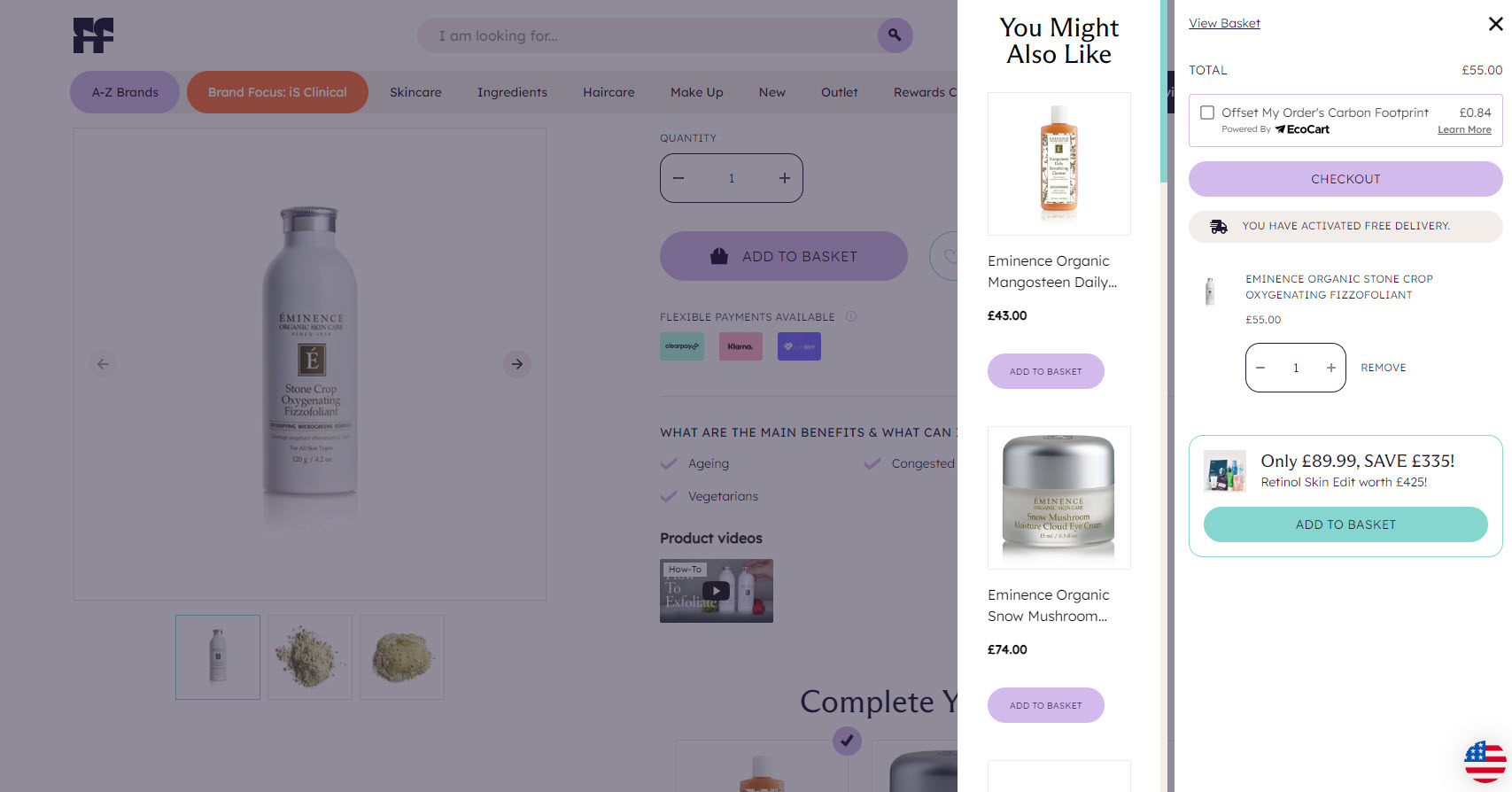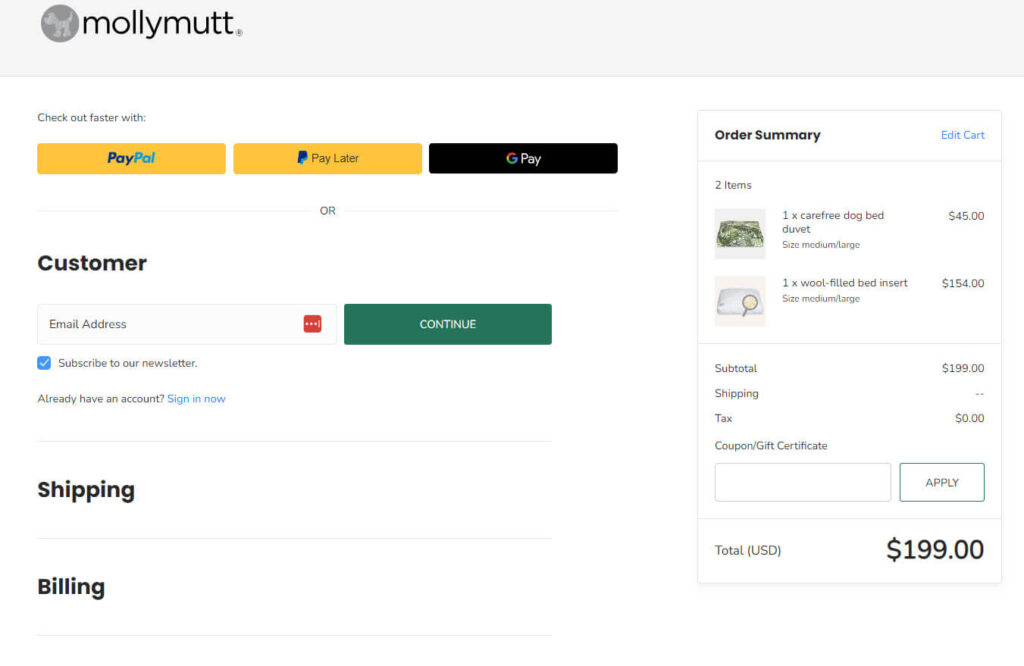Customers have come to your site, they’ve filled their cart, they’ve gotten to the checkout page, and then… nothing. What went wrong?
Shopping cart abandonment is often the result of poor checkout optimization. Online shoppers come so close to making a purchase, but something in the checkout process throws them off. Luckily for ecommerce businesses, checkout optimization can often be achieved through a few small changes. Here’s our guide.
What Is Checkout Optimization?
Checkout optimization is a series of strategies companies use to improve their ecommerce shopping cart conversion rate. According to Shopify, a good checkout conversion rate is around 2.5%. If your business sees conversions below this number, it might be time to optimize your ecommerce checkout process further. As with any business strategy, the best checkout optimization methods depend on your industry, brand, and target customers. However, there are some checkout optimization best practices that you can try to see if you can improve sales.
Learn how Tribe Kelley boosted cart conversion by 19% after partnering with EcoCart.
Why Does Checkout Optimization Matter?
A survey by Baymard found that 18% of customers have abandoned carts because the checkout process was too complicated. The same survey found that one-quarter of those surveyed had chosen not to make a purchase because the site wanted them to create an account, 14% left because the website crashed, and 11% left because the company didn’t offer enough payment options. All of these issues could have been solved with proper checkout flow optimization. Even with a beautiful online store and amazing products, a poor ecommerce checkout process could break the sale.
If you’re still unconvinced, here are some more reasons why checkout optimization matters.
- Decrease cart abandonment: Customers abandon a large portion of carts due to poor checkout optimization. Online shoppers want a streamlined shopping experience, and it doesn’t take too much to make them drop the sale. Optimizing your ecommerce checkout process will eliminate barriers that might make shoppers second-guess their purchase.
- Improve customer satisfaction: When your customers’ shopping experiences are smooth, they’re left with a good feeling. Satisfied customers come back for more and leave nice customer reviews.
- Encourage more sales: When customers enjoy a fast and easy checkout process, they’re more likely to return for more. If your ecommerce checkout page optimization is poor, even if the customer muddles through their first purchase, they might decide to go somewhere else for their next purchase. This is especially true for companies that also sell their products on Amazon or other third-party sites. If you want your customers to continue to buy directly from your site, then you need to make sure that your checkout process is seamless.
- Increase average order value (AOV): An optimized checkout process can help improve your AOV. A well-designed checkout page process will include opportunities for upselling, cross-selling, and bundling, which will improve your order values. See how Simbly increased average order value by 38%.
Download our FREE ebook:

9 Ecommerce Checkout Optimization Best Practices
Improving your ecommerce checkout process will be a matter of trying out best practices to see what works with your customers. There is no one-size-fits-all for these types of strategies, and you might need to try out a couple of methods before you determine what works best for your ecommerce store. A good checkout page experience comes down to creating a streamlined process that aligns with your brand, making your customers feel secure, and offering just enough to finalize the purchase.
Here are some checkout optimization best practices for you to try.
1. Offer carbon offsetting at checkout with EcoCart
Customers are seeking sustainable products, and they are willing to pay more for products from companies that align with their values. By offering EcoCart’s sustainable checkout option in your ecommerce store, you can display your commitment to sustainability to your customers and engage them on your sustainability journey. For sustainability-minded customers, this could be the impetus they need to complete their purchase.

Learn how Nuzest saw cart conversion soar 22% after offering carbon offsetting at checkout through EcoCart.
2. Offer a guest checkout option
The above survey by Baymard found that 25% of customers have abandoned a cart because they were required to sign up. Offering a guest checkout page option will eliminate that barrier. Instead of requiring account creation, incentivize it by offering a discount on their purchase for signing up, a freebie, or another add-on.
3. Provide multiple payment options
Another major reason customers leave their carts is a lack of payment options. Today, there are endless ways to make a payment online. Many people are wary of providing their credit card information, especially when they can use their trusted payment service, like PayPal or Venmo. Try and offer as many preferred payment method options as you can. Don’t forget about Buy Now, Pay Later options, like Affirm.
See how Molly Mutt has a super clean and simple checkout page with multiple payment options:

4. Simplify the checkout process
To keep your customers from abandoning the checkout page, avoid a complicated checkout process. If your customers are met with a very complicated checkout page, they’re more likely to give up. Don’t ask for more information than you need, keep the checkout process to one or two checkout pages, and use just a few steps. Customers don’t want to go through a five-minute process to purchase your products. Keep it as simple as possible.
5. Make it mobile-friendly
About 75% of Americans of all ages have bought something online using their phone, and among those under 50, between 87% and 92% use their phones for shopping. The future of ecommerce is mobile, and ecommerce companies need to make sure that their checkout processes are mobile-friendly. This means creating a design specifically for mobile devices, using mobile-friendly captchas, simplifying the ecommerce checkout flow for smaller screens, and creating a checkout page that’s friendly to touchscreens.
6. Offer and display loyalty rewards
People like to feel as though they’re getting a deal. According to McKinsey, top-performing loyalty programs can increase the revenue from loyalty members by 15% – 25%. Rewards programs create repeat customers, and those repeat customers will often make larger purchases if they know that they receive rewards from them. Displaying your rewards programs throughout the checkout process will help entice your customers to sign up, potentially leading to more purchases in the future.
7. Use auto-fill
Customers want a smooth and easy checkout page and checkout experience. Using auto-fill can facilitate that. Utilize Google’s Autofill and provide the option for your customers to use their shipping address as their billing address so that they don’t have to fill in that information twice. This is where encouraging your customers to create an account can come in handy, as members can continue to use the same information for future purchases.
8. Display security badges
Another big reason for cart abandonment is customers’ insecurity with the website. Cultivate a feeling of safety by partnering with and displaying security badges from well-known cybersecurity companies. You should also have your privacy policy readily available so that wary customers can be sure that you’ve done your due diligence to protect their information. For those who are extra cautious and don’t want to provide their credit card information, make sure that you accept third-party payment options like Venmo or PayPal.
9. Use reviews to your advantage
People are more likely to buy products they know others have liked, too. Include reviews alongside the pictures of the product during the checkout process so that they can be reminded that others found your products to be high-quality. If your customers are second-guessing, seeing that someone else loves your offerings might be the thing that they need to complete the purchase.
How To Deal With Checkout Cart Abandonment
Checkout optimization isn’t an exact science. Sometimes, you’ll do everything right, and still, you’ll have abandoned carts. If you’ve already optimized your checkout process to improve your conversion rate, but you still see a handful of abandoned carts, there are some things that you can do to encourage customers to come back.
- Utilize pop-ups before they leave the site: Don’t let your customers leave without a nudge. As they exit the checkout page, institute a pop-up that reminds them of key selling points, rewards, or reviews to help entice them toward the sale. However, make sure that your pop-ups aren’t too annoying. One message with a single selling point will do the trick.
- Send a reminder email: Sometimes, customers need a simple reminder to bring them back toward the purchase. If you have their information, send a personalized email gently reminding them of their shopping cart and providing personalized recommendations to bring them back to your site.
- Use UGC for social proof: User-generated content (UGC) is a great way to prove to potential customers that your product is worth buying. Create a UGC strategy to encourage current customers to post about your offerings. This may inspire those who have abandoned the checkout process to return and complete the sale.
- Offer a wishlist option: Many customers put items in their shopping carts with no intent to make a purchase that day; they’re window shopping. By offering a wishlist option, your customers can save the items they’re interested in without affecting your cart data and conversion KPIs. Additionally, they’ll be able to come back to the checkout page later and easily make the purchase when they want.
- Display your return policy: Online shopping can be stressful, especially when buying from a company for the first time. People want to be sure they can return the product if it’s not what they want without repercussions. By displaying your return policy on the checkout page, you can help alleviate those fears and help your customers feel more secure in their purchases.
Conclusion
Finalizing an online purchase and improving cart conversion is about making the checkout process faster and as smooth as possible and creating a positive purchasing experience. People want to feel good about how they shop, and a seamless checkout process produces good feelings.
Another way to cultivate positive feelings surrounding your ecommerce site is by showcasing your sustainability. EcoCart offers plenty of resources to companies seeking to reduce their carbon footprint. We’ve helped many companies like yours improve cart conversion while reaching their emissions goals. Want to learn more? Reach out to our team for a demo today.



